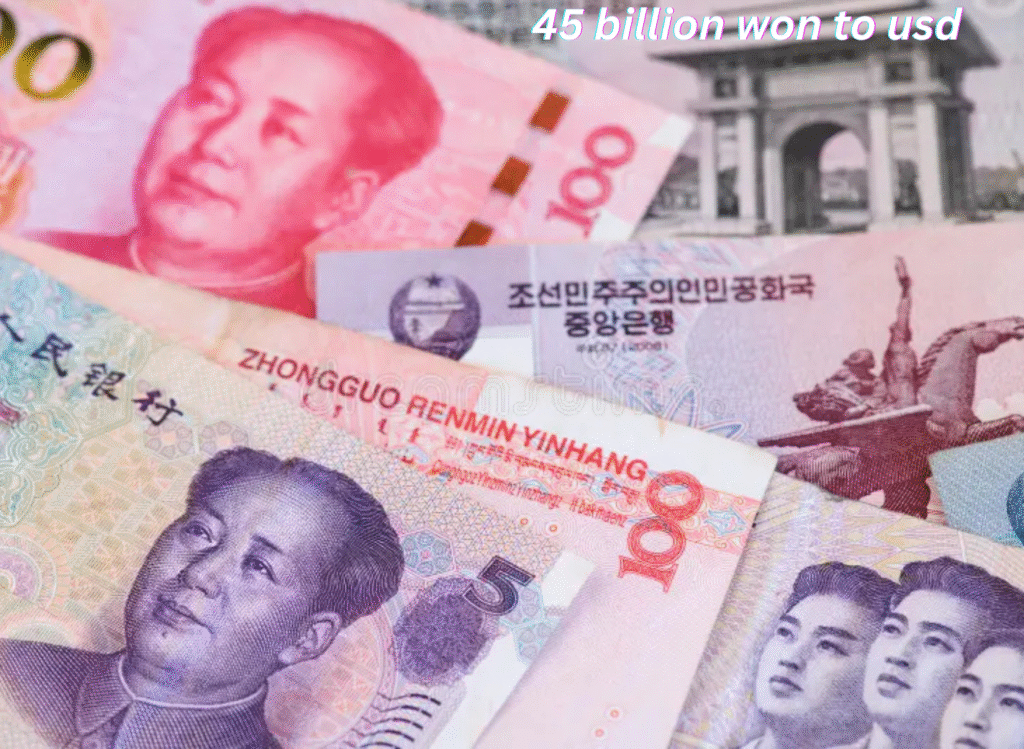45 Billion Won to USD A Deep Dive into Currency Conversion and Its Implications
Currency conversion is an essential aspect of today’s globalized financial ecosystem. Whether you’re planning an international investment, transferring funds, or simply curious about exchange rates, understanding how currency conversion works is vital. In this article, we focus specifically on converting a massive amount—45 billion South 45 billion won to usd Korean Won (KRW)—into United States Dollars (USD). At first glance, this might seem like just a numerical exercise, but it carries deeper economic and practical implications.
Why 45 billion won? This figure often appears in news stories related to corporate transactions, government funding, or international business deals involving South Korea. Understanding its equivalent in USD can provide clarity for global investors, analysts, and anyone working across international markets. In a world where financial transparency and accuracy are crucial, having a firm grasp on currency conversion can be a powerful tool.
Beyond mere arithmetic, converting currencies at this scale involves knowledge of exchange mechanisms, financial regulations, and the economic forces behind currency fluctuations. Whether you’re converting for business, investment, or academic purposes, this comprehensive guide will walk you through the process, highlight its relevance, and shed light on its broader implications. Let’s explore how 45 billion Korean won translates into U.S. dollars and what that means in today’s financial landscape.
Understanding the South Korean Won KRW and US Dollar USD
The South Korean Won (KRW) is the official currency of South Korea and is one of the most traded currencies in Asia. It is issued by the Bank of Korea, the country’s central bank, and has undergone several transformations over the decades to become the stable currency it is today. Its symbol is ₩ and it is typically denoted as KRW in financial markets. The KRW is primarily used domestically, though it has gained recognition in Asian trade due to South Korea’s strong export economy.
On the other hand, the United States Dollar (USD) is the world’s dominant reserve currency and serves as the global benchmark in finance and trade. Issued by the Federal Reserve, the USD is universally accepted and is used in over 80% of all global currency transactions. Its influence on global markets is unmatched, making it a vital metric for comparing international currencies like the KRW.
The relationship between the KRW and USD is influenced by various factors including geopolitical stability, trade relations, interest rates, inflation, and economic performance. For instance, when South Korea’s export sector performs well, the KRW tends to strengthen against the USD. Conversely, global uncertainty or economic slowdowns in South Korea can cause the won to depreciate. Understanding this interplay is key to interpreting any large-scale conversion such as 45 billion KRW.
In essence, converting KRW to USD isn’t just about numbers—it reflects a broader dialogue between two major economies. As we dive deeper, we’ll explore how this exchange actually takes place and how it affects the global financial balance.
Exchange Rate Mechanics and How Conversion Works

At its core, currency conversion relies on the current exchange rate, which tells you how much one unit of a currency is worth in another. Exchange rates can either be fixed (controlled by governments or central banks) or floating (determined by the open market). The KRW and USD both operate under a floating exchange rate system, where supply and demand dynamics, economic performance, and geopolitical events determine their relative values.
The exchange rate for KRW to USD fluctuates daily and even hourly. For example, if the current rate is 1 USD = 1,300 KRW, then 45 billion KRW would be roughly equivalent to $34.6 million USD. However, this amount can vary significantly with even a small shift in the rate. For someone dealing with billions, a fluctuation of 1–2% could mean a gain or loss of hundreds of thousands of dollars.
There are several ways to check real-time exchange rates, such as through financial news websites, forex trading platforms, or currency conversion tools like XE.com and OANDA. These tools use mid-market rates, which may differ slightly from the actual rates banks or forex brokers offer due to built-in service fees.
In large transactions, factors like interbank rates, commission structures, and transfer charges can affect the final amount received. That’s why financial institutions and multinational corporations often work with forex consultants or hedging tools to protect their funds from volatility.
Calculating 45 Billion Won to USD
To calculate 45 billion KRW to USD, the first step is to know the current exchange rate. Suppose the exchange rate is 1 USD = 1,300 KRW. To perform the conversion, you simply divide 45 billion by the exchange rate:
45,000,000,000 KRW ÷ 1,300 = 34,615,384.62 USD
This means that 45 billion Korean won would equal approximately 34.6 million US dollars at this rate. Keep in mind, however, that this is the theoretical amount based on mid-market rates. Banks and currency exchange platforms may apply a margin to the rate and charge additional transaction fees, which can affect the net amount received.
Moreover, fluctuations in the forex market can result in a different valuation even within hours. For instance, if the rate changes to 1,280 KRW per USD, the same 45 billion KRW would now be worth about $35.16 million USD—an increase of over half a million dollars without any additional funds exchanged. This example illustrates the financial impact of market dynamics and why timing is crucial in large conversions.
It’s also important to consider the purpose of the conversion. If the money is being sent for business investment, property acquisition, or corporate mergers, it may require regulatory approval in both countries. In such cases, foreign exchange contracts and hedging strategies are often employed to lock in favorable rates and minimize risk.
Economic and Practical Implications of Large Currency Conversions
When large amounts of money like 45 billion KRW are exchanged, the impact extends beyond a simple balance sheet calculation. For businesses, such conversions can affect profit margins, pricing strategies, and even stock performance. For instance, a South Korean company planning to invest in a U.S. startup must convert KRW to USD, and any fluctuation in exchange rates can either increase or reduce their purchasing power.
On a national scale, large currency conversions can influence economic indicators such as the current account balance or foreign exchange reserves. Central banks may step in to stabilize markets when massive cross-border transactions are expected. Furthermore, countries often monitor such conversions to detect capital flight, money laundering, or speculative trading, especially when large volumes are moved quickly.
In practical terms, individuals and companies must also consider the banking infrastructure. Many financial institutions impose caps on international transfers, require source verification, and mandate compliance with anti-money laundering (AML) regulations. In countries like South Korea, the Foreign Exchange Transactions Act governs such activities, requiring specific reporting for transactions over a certain threshold.
Therefore, anyone dealing with a 45 billion KRW to USD conversion must not only consider the math but also understand the legal, economic, and operational frameworks that support or hinder the process. Currency movement at this scale is both a logistical operation and a financial strategy.
Conclusion
Converting 45 billion South Korean Won to U.S. Dollars is far more than a matter of simple arithmetic. It involves a deep understanding of currency markets, economic forces, and regulatory frameworks
. From the historical significance of both KRW and USD to the technicalities of exchange rate calculations, each aspect plays a vital role in determining how much one currency is worth in terms of another—especially at such a high value.
The financial implications of such conversions affect not just individuals or corporations, but can also influence macroeconomic conditions and international relations. Whether you are an investor, policymaker, or simply curious, appreciating the complexities behind large currency transactions can lead to more informed decisions and financial literacy.
So the next time you hear about billions being transferred from one currency to another, remember—it’s not just a conversion. It’s a reflection of economic dynamics, fiscal strategy, and global interdependence.
FAQs
How much is 45 billion KRW in USD at today’s exchange rate?
This varies by the exchange rate. At 1 USD = 1,300 KRW, 45 billion KRW is approximately $34.6 million USD.
What are the best platforms for large currency conversions?
Platforms like Wise (formerly TransferWise), OFX, and Revolut are ideal for lower fees and real-time rates. For very large transfers, banks or forex consultants are recommended.
Can currency fluctuations significantly change the converted value?
Yes, even minor fluctuations can cause significant differences when converting large sums like 45 billion KRW.
Are there taxes on converting large amounts of currency?
Typically, there are no direct taxes, but service fees and compliance requirements may apply depending on the country’s laws.
How do banks and forex services calculate conversion fees?
They apply a margin to the exchange rate and may also charge flat or percentage-based service fees.
You May Also Read: https://otswroldtime.com/best-berberine-supplement/














Post Comment